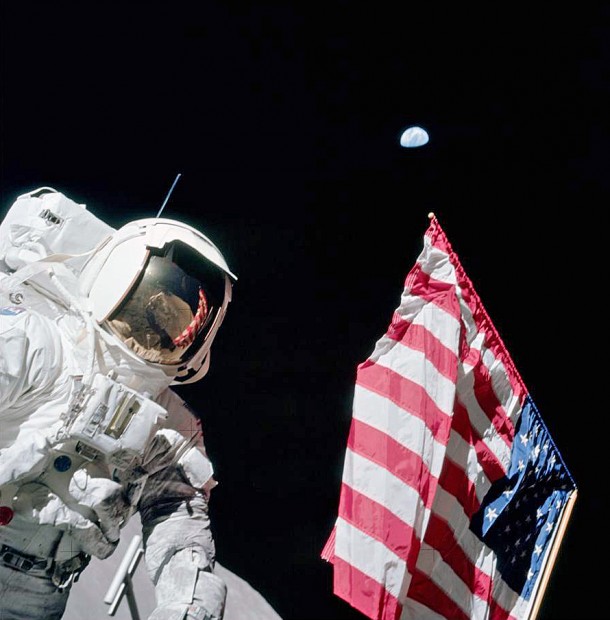
Forty-two years ago this month, NASA successfully conducted the sixth lunar landing mission of the Apollo Program. Known as Apollo 17, the flight marked the last time that men from the planet Earth explored the surface of the Moon.
Apollo 17 was launched from LC-39A at Cape Canaveral, Florida on Thursday, 07 December 1972. With a lift-off time of 05:33:00 UTC, Apollo 17 was the only night launch of the Apollo Program. Those who witnessed the event say that night turned into day as the incandescent exhaust plumes of the Saturn V’s quintet of F-1 engines lit up the sky around the Cape.
The target for Apollo 17 was the Taurus-Littrow valley in the lunar highlands. Located on the southeastern edge of Mare Serenitatis, the landing site was of particular interest to lunar scientists because of the unique geologic features and volcanic materials resident within the valley. Planned stay time on the lunar surface was three days.
The Apollo 17 crew consisted of Commander Eugene A. Cernan, Command Module Pilot (CMP) Ronald E. Evans and Lunar Module Pilot (LMP) Harrison H. Schmitt. While this was Cernan’s third space mission, both Evans and Schmitt were space rookies. Astronaut Schmitt was a professional geologist and the only true scientist to explore the surface of the Moon.
With Evans circling the Moon solo in the Command Module America, Cernan and Schmitt successfully landed their Lunar Module Challenger at 19:54:57 UTC on Monday, 11 December 1972. Their lunar stay lasted more than three days. The astronauts used the Lunar Rover for transport over the lunar surface as they conducted a trio of exploratory excursions that totaled more than 22 hours.
Cernan and Schmitt collected nearly 244 pounds of lunar geologic materials while exploring Taurus-Littrow. As on previous missions, the Apollo 17 crew deployed a sophisticated set of scientific instruments used to investigate the lunar surface environment. Indeed, the Apollo Lunar Surface Experiments Package (ALSEP) deployed during during lunar landing missions measured and transmitted vital lunar environmental data back to Earth through September 1977 when the data acquisition effort was officially terminated.
The Apollo 17 landing party departed the Moon at 22:54:37 UTC on Thursday, 14 December 1972. In a little over two hours, Challenger and America were docked. Following crew and cargo transfer to America, Challenger was later intentionally deorbited and impacted the lunar surface. The Apollo 17 crew then remained in lunar orbit for almost two more days to make additional measurements of the lunar environment.
At 23:35:09 UTC on Saturday, 16 December 1972, Apollo 17 blasted out of lunar orbit and headed home. Later, CMP Ron Evans performed a trans-Earth spacewalk to retrieve film from Apollo 17 ’s SIM Bay camera. Evans’ brave spacewalk occurred on Sunday, 17 December 1972 (69th anniversary of the Wright Brothers first powered flight) and lasted 65 minutes and 44 seconds.
Apollo 17 splashdown occurred near America Samoa in the Pacific Ocean at 19:24:59 UTC on Tuesday, 19 December 1972. America and her crew were subsequently recovered by the USS Ticonderoga.
Apollo 17 set a number of spaceflight records including: longest manned lunar landing flight (301 hours, 51 minutes, 59 seconds); longest lunar stay time (74 hours, 59 minutes, 40 seconds); total lunar surface extravehicular activity time (22 hours, 3 minutes, 57 seconds); largest lunar sample return (243.7 pounds), and longest time in lunar orbit (147 hours, 43 minutes, 37 seconds).
Apollo 17 successfully concluded America’s Apollo Lunar Landing Program. Of a sudden it seemed, America’s — and the world’s — greatest adventure was over. However, the anticipation was that the United States would return in the not-too-distant future. Indeed, Gene Cernan, the last man to walk on the Moon, spoke the following words from the surface:
“As I take man’s last step from the surface, back home for some time to come — but we believe not too long into the future — I’d like to just [say] what I believe history will record — that America’s challenge of today has forged man’s destiny of tomorrow. And, as we leave the Moon at Taurus-Littrow, we leave as we came and, God willing, as we shall return, with peace and hope for all mankind. Godspeed the crew of Apollo 17.”
It has now been 42 years since the Commander of Apollo 17 spoke those stirring words from the valley of Taurus-Littrow. Gene Cernan and most space experts of his day figured we would surely be back by now. Certainly in the 20th century. Yet, there has been no return. Moreover, there is no formal plan or funded program in the 21st century to do so. And so, the historical record continues to list the name of Eugene A. Cernan as the last man to walk on the Moon.
Okay America, here’s some questions to ponder. When will we go back to the Moon? By extension, how about Mars and beyond? Are our greatest space achievements behind us or is the best yet to come? Are we a nation of used-to-be’s or are we that bastion of freedom where even the impossible is achievable? Does it matter? Does anyone even care? You choose.
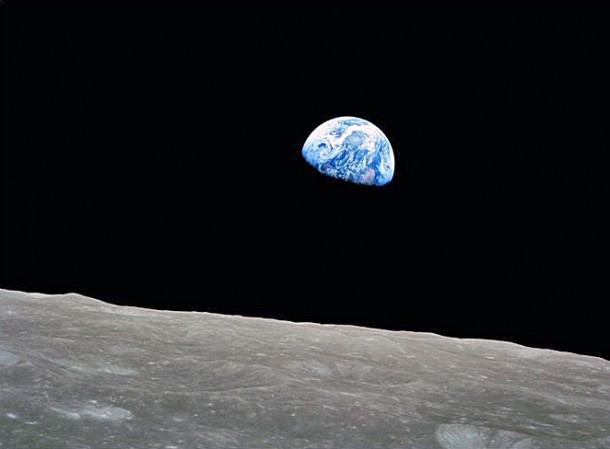
Forty-six years ago this month, three American astronauts became the first men to orbit the Earth’s Moon during the flight of Apollo 8. This epic mission also featured the first manned flight of the mighty Saturn V launch vehicle as well as history’s first superorbital entry of a manned spacecraft.
Following the Apollo 1 tragedy in January of 1967, the United States would not fly another manned space mission until October 1968. That flight, Apollo 7, was a highly successful earth-orbital mission in which the new Block II Apollo Command Module was thoroughly flight-proven.
Notwithstanding Apollo 7’s accomplishments, only 14 months remained for the United States to meet the national goal of achieving a manned lunar landing before the end of the 20th century’s 7th decade. The view held by many in late 1968 was that an already daunting task was now unachievable in the narrow window of time that remained to accomplish it.
The pessimism about reaching the Moon before the end of the decade was easy to understand. The Saturn V moon rocket had not been man-rated. The Lunar Module had not flown. Lunar Orbit Rendezvous (LOR) was untried. Men had not even so much as orbited the Moon. Yet, history would record that the United States would find a way to accomplish that which had never before been achieved.
George Low, manager of NASA’s Apollo Spacecraft Program Office, came up with the idea. Low proposed that the first manned flight of the Saturn V be a trip all the way to the Moon. It was something that Low referred to as the “All-Up Testing” concept. The newly-conceived mission would be flown in December 1968 near Christmas time.
While initially seen as too soon and too risky by many in NASA’s management hierarchy, Low’s bold proposal was ultimately accepted as the only way to meet the national lunar landing goal. Yes, there was additional risk. However, the key technologies were ready, the astronauts were willing, and the risk was tolerable.
Apollo 8 lifted-off from LC-39A at the Kennedy Space Center in Florida on Saturday, 21 December 1968 at 12:51 hours UTC. The crew consisted of NASA astronauts Frank Borman, James A. Lovell, Jr. and William A. Anders. Their target – the Moon – was 220,000 miles away.
After a 69-hour outbound journey, Apollo 8 entered lunar orbit on Tuesday, 24 December 1968 – Christmas Eve. The Apollo 8 crew photographed the lunar surface, studied the geologic features of its terrain, and made other observations from a 60-nautical mile circular orbit. The spacecraft circled the Moon 10 times in slightly over 20 hours.
The most poignant and memorable event in Apollo 8′s historic journey occurred on Christmas Eve night when each of the flight crew took turns reading from the Book of Genesis in the Holy Bible. The solemnity of the moment was evident in the voices of the astronauts. They had seen both the Moon and the Earth from a perspective that none before them had. Fittingly, they expressed humble reverence for the Creator of the Universe on the anniversary of the birth of mankind’s Redeemer.
Apollo 8 departed lunar orbit a little over 89 hours into the mission. Following a nearly 58-hour inbound trip, Apollo 8 reentered the earth’s atmosphere at 36, 221 feet per second on Friday, 27 December 1968. The first manned superorbital reentry was performed in total darkness. It was entirely successful as Apollo 8 landed less than 1 nautical mile from its target in the Pacific Ocean. The USS YORKTOWN effected recovery of the weary astronauts and their trustworthy spacecraft. Mission total elapsed time was 147 hours and 42 seconds.
The year 1968 was a tumultuous one for the United States of America. Martin Luther King and Robert Kennedy had been assassinated. American military blood flowed on the battlefields of Vietnam and civilian blood was let in countless demonstrations taking place in the nation’s cities. The ill-posed sexual revolution continued to eat away at the country’s moral moorings.
But, as is so often the case, an event from the realm of flight, now newly extended to lunar space, reminded us of our higher nature and potential. For a too brief moment, Apollo 8 put our collective purpose for being here into sharp focus. Perhaps a short phrase in a telegram sent to Frank Borman from someone he had never met said it best: “You saved 1968!”
However, looking through the lens of history, we now know that Apollo 8 did much more than end the penultimate year of the 1960’s on a positive note. Indeed, it may be said that Apollo 8 saved the entire Apollo Program.
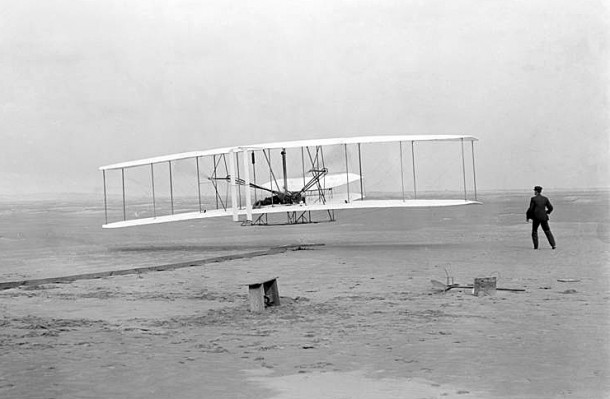
One-hundred and eleven years ago this month, the Wright Flyer became the first aircraft in history to achieve powered flight. The site of this historic event was Kill Devil Hills situated near Kitty Hawk, North Carolina.
Americans Wilbur and Orville Wright began their legendary aeronautical careers in 1899. In a matter of just four short years, the brothers would go from complete aeronautical novices to inventors and pilots of the world’s first successful powered aircraft. Interestingly, neither man attended college nor received even a high school diploma.
The Wright Flyer measured roughly 21 feet in length and had a wing span of approximately 40 feet. The biplane aircraft had an empty weight of 605 lbs. Power was provided by a single 12 horsepower, 4-cylinder engine that drove twin 8.5 foot , two-blade propellers.
The Flyer made a powered take-off run along a 60-foot wooden guide rail. The aircraft was mounted on a two-wheel dolly that rode along the track and was jettisoned at lift-off. The Flyer pilot lay prone in the middle of the lower wing. Twin elevator and rudder surfaces provided pitch and yaw control, respectively. Roll control was via differential wing warping.
The Wright Brothers had come close to achieving a successful powered flight with the Wright Flyer on Monday, 14 December 1903. Wilbur, who had won the coin toss, was the pilot for the initial attempt. However, the Flyer stalled and hit the ground sharply just after take-off. Wilbur was unhurt, but repair of the damaged aircraft would take two days.
The next attempt flight took place on Thursday, 17 December 1903. The weather was terrible. Windy and rainy. Even after the rain abated, the wind continued to blow in excess of 20 mph. The Wrights decided to fly anyway. It was now Orville’s turn as command pilot.
Orville took his position on the Flyer and was quickly launched into the wind. Once airborne, the aircraft proved difficult to control as it porpoised up and down along the flight path. Nonetheless, Orville kept the Flyer in the air for 12 seconds before landing 120 feet from the take-off point. Other than a damaged skid, the aircraft was intact and the pilot unhurt. Powered flight was a reality!
Three more flights followed on that momentous occasion as the two brothers alternated piloting assignments. The fourth flight was the longest in both time aloft and distance flown. With Wilbur at the controls, the Wright Flyer flew for 59 seconds and landed 852 feet from the take-off point.
The Wright Brothers father, Milton, would soon learn of the epic events that December day in North Carolina. Orville’s verbatim Western Union telegram message sent to Dayton, Ohio read:
Success four flights thursday morning all against twenty one mile wind started from level with engine power alone average speed through air thirty one miles longest 57 [sic] seconds inform press home Christmas.
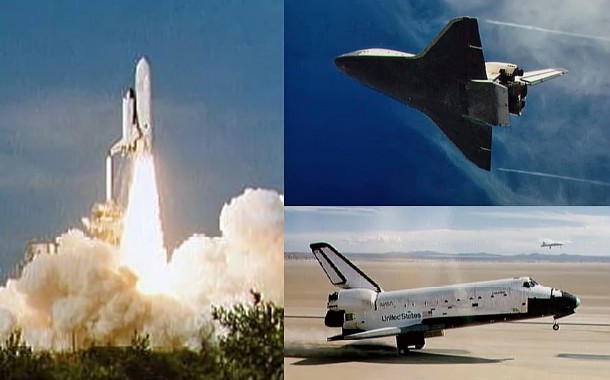
Thirty-three years ago this week, the Space Shuttle Columbia completed the second mission of the Space Shuttle Program. Designated STS-2, the mission marked the first reuse of a space vehicle for manned orbital flight.
America’s early manned spacecraft – Mercury, Gemini and Apollo – were single-flight vehicles. That is, a new spacecraft was required for each space mission. This was appropriate for meeting the aims of the early space program which concentrated on getting America to the moon before the end of the 1960′s.
The concept of space vehicle reusability came into vogue with the introduction of the Space Transportation System (STS). The original goal of the STS was to provide frequent and routine access to space via a fleet of Space Shuttle vehicles. For the STS to achieve economic viability, this meant flying a Space Shuttle once every two weeks. History has shown that this projected flight rate was optimistic to say the least.
The Space Shuttle vehicle was ultimately configured as a 3-element system consisting of (1) a winged orbiter, (2) a pair of solid rocket boosters (SRB’s) and (3) an external tank (ET). Both the orbiter and the SRB’s were designed to be reusable. The ET would be the only disposable element of the system since higher costs would be incurred in the recovery and refurbishment of this piece of flight hardware than in simply using a new one for each flight.
The Space Shuttle was designed to haul large payloads; on the order of 60,000 and 50,00 lbs into and out of orbit, respectively. With a maximum landing weight of 230,000 lbs, the Space Shuttle Orbiter needed wings to generate the required aerodynamic lift force. Wings were needed to satisfy the Orbiter’s 1,100-nm entry cross range requirement as well.
Following the successful first flight (STS-1) of the Space Shuttle Columbia in April of 1981, preparations began immediately to ready the Orbiter for its equally monumental second flight. The STS-2 flight crew would consist of Commander Joe Henry Engle and Pilot Richard Harrison Truly. STS-2 would be the first orbital spaceflight for both men.
On Thursday, 12 November 1981, the Space Shuttle Columbia lifted-off at 15:09:59 UTC from Cape Canaveral’s LC-39A. Ascent flight was nominal and Columbia was placed into a 125-nm x 120-nm orbit. At this point, Columbia became the first manned spacecraft to achieve Earth-orbit twice. It was an extra special occasion for Richard Truly inasmuch as it was his 44th birthday.
Engle and Truly anticipated 5-days in orbit with their orbital steed. However, one of Columbia’s three fuel cells failed early-on and the mission was reduced to just over two days. Nonetheless, the crew achieved 90 percent of the mission’s goals. They even remained awake during a scheduled sleep period to exercise the new Canadian Remote Manipulator System (RMS).
On Saturday, 14 November 1981, Columbia and her crew successfully completed STS-2 by landing on Rogers Dry Lake at Edwards Air Force Base, California. Main gear touchdown occurred at 21:23:11 UTC. Joe Engle flew the entire reentry manually. He holds the distinction of being the only pilot to manually fly a lifting space vehicle all the way from orbit to landing. Engle completed a total of 29 Programmed Test Input (PTI) aerodynamic maneuvers in the process.
STS-2 was a monumental success. Columbia became the first space vehicle to be reused for manned orbital space operations. Other Orbiters would follow including Challenger, Atlantis, Discovery and Endeavor. In 30 years of service ending in July 2011, the Space Shuttle Program would eventually fly 135 orbital space missions.
As a footnote, Joe Engle went on to command one more Space Shuttle mission in 1985 (STS-51I). He retired from the USAF in November of 1986. Richard Truly served as Commander of STS-8 in 1983. That mission featured the first night launch and landing of the Space Shuttle. Richard Truly also served as NASA Administrator from May of 1989 to May of 1992.
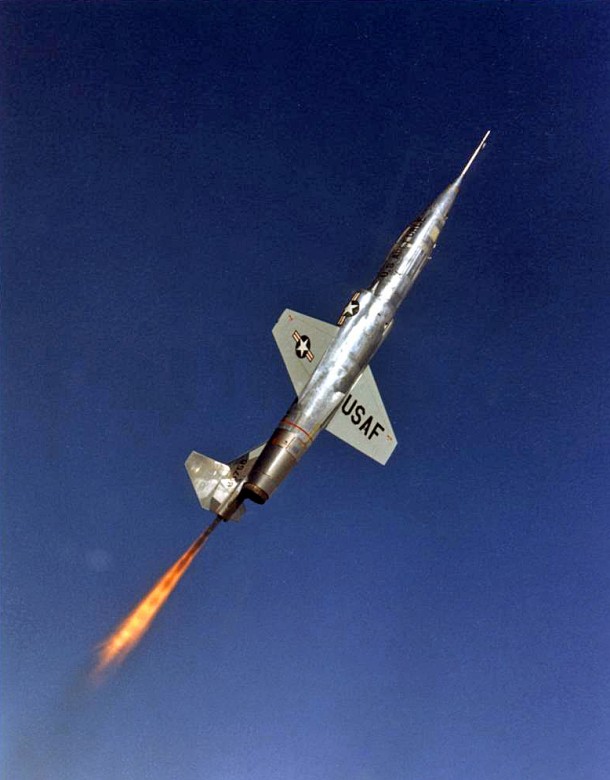
Fifty-one years ago this week, USAF Major Robert W. Smith zoomed the rocket-powered Lockheed NF-104A to an unofficial world record altitude of 120,800 feet. This mark still stands as the highest altitude ever achieved by a United States aircraft from a runway take-off.
A zoom maneuver is one in which aircraft kinetic energy (speed) is traded for potential energy (altitude). In doing so, an aircraft can soar well beyond its maximum steady, level altitude (service ceiling). The zoom maneuver has both military and civilian flight operations value.
The USAF/Lockheed NF-104A was designed to provide spaceflight-like training experience for test pilots attending the Aerospace Research Pilot School (ARPS) at Edwards Air Force Base, California. The type was a modification of the basic F-104A Starfighter aircraft. Three copies of the NF-104A were produced (S/N’s 56-0756, 56-0760 and 56-0762). It was the ultimate zoom flight platform.
In addition to a stock General Electric J79-GE-3 turbojet, the NF-104A was powered by a Rocketdyne LR121-NA-1 rocket motor. The J79 generated 15,000 pounds of thrust in afterburner and burned JP-4. The LR-121 produced 6,000 pounds of thrust and burned a combination of JP-4 and 90% hydrogen peroxide. Rocket motor burn time was on the order of 90 seconds.
The NF-104A was kinematically capable of zooming to altitudes approaching 125,000 feet. As such, it was a combined aircraft and spacecraft. The pilot had to blend aerodynamic and reaction controls in the low dynamic pressure environment near the zoom apex. He was also required to fly in a full pressure suit for survival at altitudes beyond the Armstrong Line.
On Friday, 06 December 1963, Bob Smith took-off from Edwards and headed west for the Pacific Ocean. Out over the sea, he changed heading by 180 degrees in preparation for the zoom run-in. At a point roughly 100 miles out, Smith then accelerated the NF-104A (S/N 56-0760) along a line that would take him just north of the base. Arriving at Mach 2.4 and 37,000 feet, Smith then initiated a 3.75-g pull to a 70-degree aircraft pitch angle. Turbojet and rocket were at full throttle.
Things happened very quickly now. Smith brought the turbojet out of afterburner at 65,000 feet and then moved the throttle to the idle detent at 80,000 feet. The rocket motor burned-out around 90,000 feet. Smith controlled the aircraft (now spacecraft) over the top of the zoom using 3-axis reaction controls. The NF-104A’s arcing parabolic trajectory subjected him to 73 seconds of weightlessness. Peak altitude achieved was 120,800 feet above mean sea level.
On the back side of the zoom profile, Bob Smith restarted the windmilling J79 turbojet and set-up for landing at Edwards. He touched down on the main runway and rolled out uneventfully. Total mission time from brake-release to wheels-stop was approximately 25 minutes.
Much more could be said about the NF-104A and its unique mission. Suffice it to say here that two of the aircraft ultimately went on to serve in the ARPS from 1968 to 1971. The only remaining aircraft today is 56-0760 which sits on a pole in front of the USAF Test Pilot School (TPS) at Edwards.
Bob Smith went on to make many other noteworthy contributions to aviation and his nation. Having flown the F-86 Sabre in Korea, he volunteered to fly combat in Viet Nam in his 40th year. Stationed at Korat AFB in Thailand, he commanded the 34th Fighter Squadron of the 388th Tactical Fighter Wing. Smith flew 100 combat missions in the fabled F-105D Thunderchief; many of which involved the infamous Pack VI route in North Viet Nam.
Bob Smith was a true American hero. Like so many of the airmen of his day, Smith was a man whose dedication, service, and courage went largely unnoticed and unappreciated by his fellow countrymen. Bob Smith’s final flight came just 3 months shy of his 82nd birthday on Thursday, 19 August 2010.






